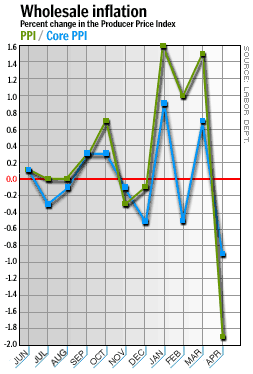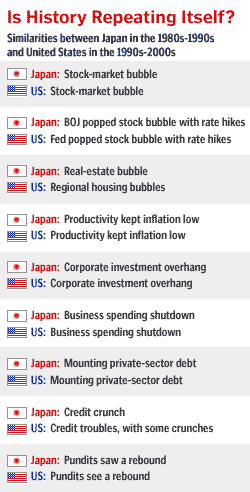NEW YORK (CNN/Money) -
For months, policy-makers, investors and economists have listened anxiously for the shuddering footfall of deflation, the dreaded monster that has terrorized Japan for almost a decade and may be set to wade across the Pacific to wreak havoc in the United States.
On Thursday, when the government said its producer price index (PPI) posted the biggest drop on record last month -- after Wednesday's report of a record fall in import prices -- some folks thought they heard that footfall.
"Those who fear deflation thought they were watching a horror flick this morning when the PPI was reported as falling 1.9 percent in April," said Brian Wesbury, chief economist at Griffin Kubik Stephens & Thompson, an investment firm in Chicago.

The result: a rumor buzzing through the bond market that the Federal Reserve would hold an emergency meeting, along with a brief surge in 10- and 30-year Treasury prices, as some traders thought the Fed might soon act on its plans to bring down long-term interest rates.
But many economists say these traders are nervous Nellies, noting that producer prices and import prices were driven mostly by a steep drop in oil prices, which had surged in the months leading up to the U.S. war with Iraq.
Excluding prices for oil, tobacco, cars and light trucks, wholesale prices actually rose in April. In other words, false alarm. No need to summon Mothra just yet.
"The PPI just feeds the deflation talk that's run rampant in the past month or so," said Anthony Crescenzi, bond market strategist at Miller Tabak & Co. "It's upsetting for someone who believes deflation is on the way. Even though there are qualifiers for the April data, that headline is dramatic enough to convince them."
The Fed did not respond to questions about whether or not an emergency meeting was scheduled, though a representative of the New York branch of the central bank said she was unaware of any such meeting.
Still, the PPI and import price reports had to catch the attention of the central bank's policy-makers, who last week said they were more worried about possible deflation -- when prices fall uncontrollably, hurting corporate profits and leading to an economic slowdown -- rather than the opposite, inflation.
At first blush, deflation may sound like a good thing, especially since the Fed for decades had been battling possible inflation. But it's murder for corporate profits.
Deflation means companies can't raise prices. In order to keep costs low, they avoid hiring workers and delay raises, keeping wages low. That in turn would hurt consumer spending, which fuels two-thirds of the economy. And weak consumer demand would put further downward pressure on prices, starting the whole miserable cycle all over again.
For Exhibit A, please see Japan, circa the mid-1990s to present.

Though most economists discounted the latest reports, and said Friday's expected decline in April consumer prices could also be discounted mostly due to falling oil prices, the reports are red-light indicators that at the least inflation is an extremely distant threat, meaning the Fed is unlikely to raise interest rates any time soon.
"Wholesale prices are going nowhere," said Joel Naroff, president and chief economist at Naroff Economic Advisors. "We don't have deflation, but clearly there is no reason to expect prices to jump."
Since last summer, Fed policy-makers have been openly discussing the lessons of Japan -- whose economic situation in the 1980s and 1990s bears an eerie resemblance to the U.S. economic situation in the 1990s and 2000s -- and tools they could use to fight deflation in the United States.
Fed policy-makers still have 1.25 percentage points on the federal funds rate, their key short-term interest rate, and they could buy long-term Treasurys and other issues in a bid to manipulate short- and long-term rates.
Though most economists doubt the Fed will cut rates again, the mere expectation of low rates for the foreseeable future, along with the Fed's jawboning -- "Open Mouth Operations," some economists call it -- about unusual tricks it could use to fight deflation, have already brought long-term bond market rates sharply lower.
The yield on the 30-year Treasury bond has tumbled to 4.45 percent from 4.75 percent on March 6, when the Fed formally announced it was on the lookout for deflation. Yields and prices move in the opposite direction -- the drop in yields has been due to the rush to buy the bonds.
But bond market analysts warned that, if economic data continue to show signs of improvement, and if stock prices continue to rise, then the latest rally in the 30-year bond could do a 180 in a hurry.
"There could be a dramatic turn in rates," said Crescenzi of Miller Tabak. "I'm expecting a half-percentage-point move to the upside [in yields] when the turn comes, and I think that will happen within a month."
But some analysts said a weak reading in the Consumer Price Index, due Friday, could trigger deflation worries again, reinforcing the idea of low rates and fueling another rush into bonds.
"This buying frenzy could come back at any time," bond analyst Phil Flynn of Alaron Trading told CNNfn. "One bad economic report, or maybe a selloff in the stock market, could get things exciting here again. If the CPI shows a big drop, you'd better look out."

|

